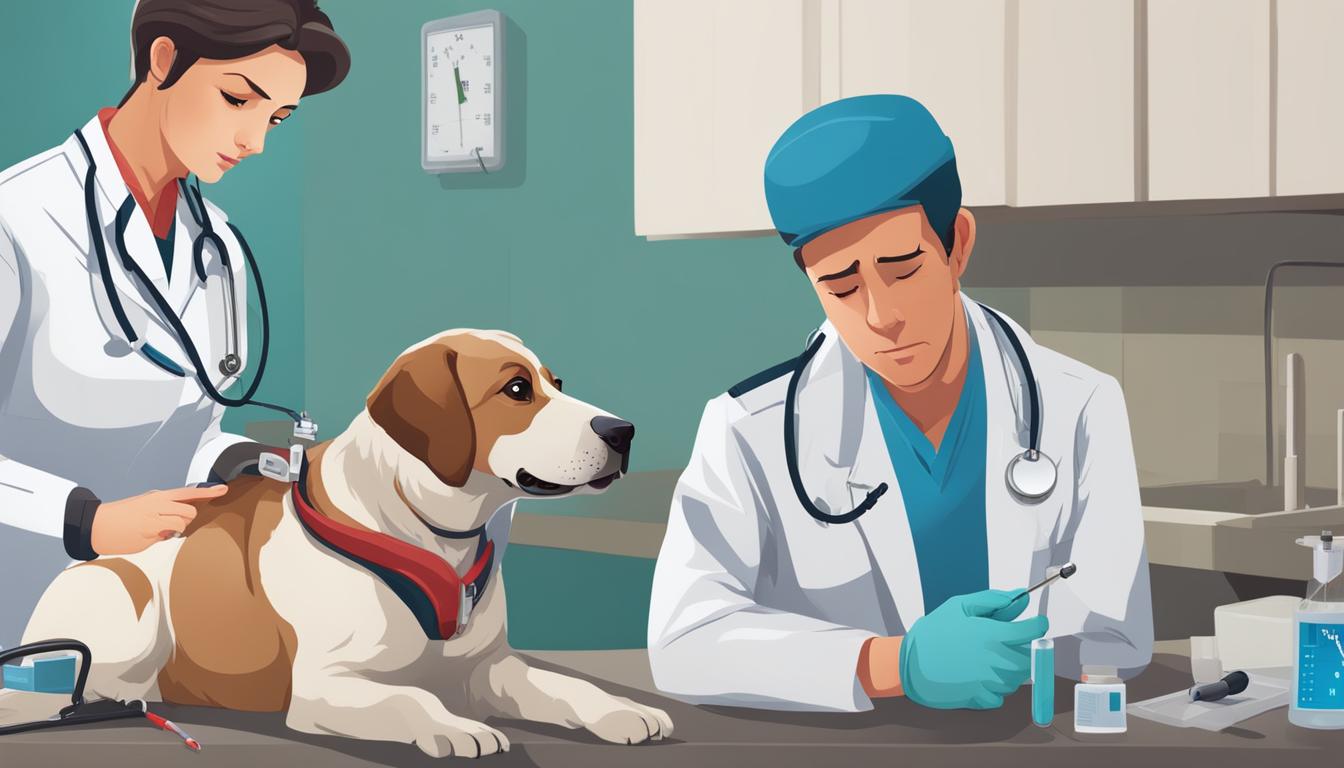Hey there! Did you know that something called a bacterial infection in dogs can be really serious? Sometimes, an infection that starts small can get worse and lead to a big problem called sepsis in dogs. Sepsis is when the body gets very upset by an infection and can’t fight it the right way. This can make a dog feel very sick and might even be life-threatening. That’s why it’s super important to know about canine bacterial diseases and pet health emergencies. If we can spot these signs early, we can help our furry friends feel better with the help of a vet!
If you see your dog feeling sick, acting tired or weird, it’s like a big red flag saying, “Hey, look at me! I need help!” That’s when you and your family should take your dog to see the vet really fast. A vet is a doctor for animals, and they can do a lot to make dogs healthier. Keeping all our pets healthy and happy is what we all want, right?
Key Takeaways
- If a dog gets a bacterial infection, it can be dangerous.
- Sepsis in dogs is like a big alarm bell for vet help.
- Canine bacterial diseases need quick care so they don’t get worse.
- Knowing about pet health emergencies can save a dog’s life.
- Feeling sick or acting strange can mean your dog needs a vet.
- Your family and a vet can work together to keep your pet safe and healthy.
Understanding Sepsis in Dogs: A Lethal Response to Infection
When your furry friend gets sick, it’s really important to know what might be happening inside their body. Sepsis is one big word that could mean a big problem for dogs. It happens when the body tries too hard to fight off an infection and ends up hurting itself.
Defining Sepsis in Canine Patients
Imagine your dog’s body like a superhero team. Usually, they fight off the bad guys, which are the germs. But with sepsis, it’s like the superheroes are fighting too hard and begin to damage the city they’re trying to save.
The Severity Spectrum of Sepsis: From Inflammation to Multiple Organ Dysfunction
Sepsis can start out as just a little bit of a problem, but it can get worse really fast. Think of it like a small fire that can turn into a huge wildfire inside your dog’s body.
| Stage | What’s Happening in the Body | What It Means for Your Dog |
|---|---|---|
| 1. Inflammation (SIRS) | The body starts to overreact to an infection. | Your dog might start feeling unwell or act differently. |
| 2. Severe Sepsis | The fire spreads and begins to hurt organs. | Your dog could get sicker quickly as organs struggle. |
| 3. Septic Shock | The organs start to fail because they’re damaged. | This is super serious and can make it hard for your dog to survive. |
Why Immediate Veterinary Intervention is Critical
Because sepsis is such a big deal, getting your dog to the vet right away can help stop the problem before it gets too big. It’s like having firefighters come to put out the fire before it’s a wildfire.
Everyone wants their pets to be happy and healthy, so knowing about sepsis causes, the canine systemic inflammatory response, and organ failure in dogs can help keep your furry friend safe. If you think something might be wrong, it’s always good to have a veterinary emergency team look at your best pal to help them feel better!
Recognizing the Symptoms: Could Your Dog Have Sepsis?
Is your furry friend not acting like themselves? It could be more serious than you think. Symptoms of sepsis in dogs can be tough to spot, but knowing what to look for might save your pet’s life. Here are some veterinary signs of infection that should have you on alert.
Common Signs Indicative of Sepsis
When dogs get really sick, they can’t tell us what’s wrong. It’s up to you to watch for signs that something isn’t right. Some symptoms of sepsis in dogs include:
- Vomiting
- Diarrhea
- Not wanting to eat (lack of appetite)
- Acting very tired or weak
- Having a hot body (fever)
- Seeming confused
- Heart beating super fast
- Quick breathing
- Low blood pressure, which might make them faint
These signs might look different depending on where in the body the infection is. We must keep a caring eye on our four-legged pals to help them feel better.
When to Seek Emergency Care for Your Pet
If your dog is showing to have any of these troubles, it’s very important to take your dog to the vet quickly – especially if these things happen after an injury or surgery. Don’t wait! Getting help right away is the best thing you can do for your dog. Going to the vet on time can make all the difference for your sick pet.
Common Culprits: What Causes Sepsis in Dogs?
When we think of our furry friends, we want them to be happy and healthy. But sometimes, they can get sick with gastrointestinal infections in dogs or other kinds of bacterial infections in pets. These infections can be scary because they might lead to something called sepsis. Let’s learn about the usual causes of this big problem. Also, remember, a healthy pup is a happy pup!
The Role of Gastrointestinal Tract Infections
Imagine your dog’s GI tract like a long winding river inside their body. This river is very important because it helps break down food and protects against bad germs. But what happens when it gets infected? It can lead to some serious troubles. Some of these tummy bugs are not just mean; they’re strong enough to go into the blood and make your pet very sick. It can turn into something called sepsis, which is a big word for when the body is trying really hard to fight those germs.
Other Origins of Infection Leading to Sepsis
But wait, there’s more. It’s not just tummy troubles that can cause sepsis in dogs. Did you know that even a small cut or a sore tooth can be one of the sources of canine sepsis? Yes, it’s true! Other places like the lungs, mouth, bladder, or even a scrape on the skin can be starting points for nasty bugs to enter and spread. You see, our doggy friends need our help to keep these bugs away. With lots of love and care, we can watch out for these signs and keep our pets safe.
| Infection Source | Consequences | Prevention Tips |
|---|---|---|
| Gastrointestinal Tract | Tummy pains, vomiting, diarrhea | Keep away from spoiled food; clean water |
| Skin Wounds | Infection, fever | Clean wounds, watch for redness |
| Oral Cavity | Bad breath, pain eating | Regular dental check-ups |
| Urinary Tract | Struggling to pee, crying | Fresh water, bathroom breaks |
| Respiratory System | Coughing, trouble breathing | Fresh air, no smoke |
Always remember, your pet counts on you to stay on top of these things. When you keep an eye on where sepsis can come from, you’re taking big steps to keep your four-legged companions wagging their tails. Stay aware, and give them the happy, barky life they deserve!
How Do Veterinarians Diagnose and Treat Sepsis?
If your furry friend is acting sick, a veterinarian can check if it’s sepsis. They look at your dog’s health history and how they are acting now. The vet might do a blood test or check your dog’s pee to learn more.
The Diagnostic Process: From Medical History to Bloodwork
For diagnosing sepsis in dogs, the vet uses lots of tools. They ask about your pet’s past illnesses and check for signs like fever or feeling weak. They take samples of blood and pee to test in a lab. This helps them figure out if your pet has sepsis.
Potential Treatments: Hospitalization, Medication, and Surgery
If a dog has sepsis, they may need to stay at the vet hospital. They would get fluids through a tube in their vein, medicine to keep their blood pressure okay, and antibiotics for dogs to fight the germs. Sometimes, a vet needs to do surgery to get rid of the bad germs. Quick help can save a dog’s life.
FAQ
Can a bacterial infection be fatal to a dog?
Yes, a bacterial infection can lead to a life-threatening condition called sepsis, which can cause multiple organ dysfunction and possibly death if not treated promptly. It’s essential to get urgent veterinary care if you suspect your dog has a severe infection.
What exactly is sepsis in dogs?
Sepsis in dogs is an extreme response of the body to an infection that causes widespread inflammation, severe sepsis with potential **organ damage**, and septic shock that can result in organ failure. It can be caused by bacteria, viruses, parasites, or fungi, and urgent veterinary intervention is crucial.
How can I recognize if my dog might have sepsis?
Symptoms of sepsis in dogs can vary but often include vomiting, diarrhea, lack of appetite, weakness, fever, confusion, **rapid heartbeat**, and breathing difficulties, along with low blood pressure. These signs can indicate a severe infection, especially after an injury or surgery, and you should seek emergency veterinary care immediately.
What are some common causes of sepsis in dogs?
Sepsis in dogs can originate from infections in various parts of the body, including the gastrointestinal tract, respiratory system, oral cavity, urinary tract, wounds, or reproductive organs. Infections like **parvovirus**, peritonitis, and severe dental disease can also introduce harmful bacteria into the bloodstream.
How will a veterinarian diagnose and treat sepsis in my dog?
Veterinarians diagnose sepsis by evaluating your dog’s medical history, symptoms, and through various tests, such as **blood counts** and urine analysis. Treatment may involve hospitalization, IV fluids, medications for blood pressure, antibiotics, oxygen therapy, and possibly emergency surgery. The sooner the treatment starts, the better the chances of recovery.
When should I take my dog to the vet for a suspected infection?
If you notice any signs of infection or illness, such as lethargy, vomiting, diarrhea, or a wound that’s not healing, you should take your dog to the vet promptly. Early intervention is key in preventing conditions like sepsis that can stem from untreated infections.
Are antibiotics always necessary for treating sepsis in dogs?
Antibiotics are a critical component of treating bacterial infections that lead to sepsis. The specific antibiotics used will depend on the infection type and your dog’s overall health. Additional treatments may also be necessary, depending on the severity of your dog’s condition.
Is hospitalization always required for dogs with sepsis?
Hospitalization is often necessary for dogs with sepsis due to the severity of the condition and the need for intensive care. This may include intravenous fluids, medications to support blood pressure and organ function, and close monitoring by veterinary professionals.
Can canine vaccinations help prevent sepsis?
While vaccinations can help prevent certain diseases that may potentially lead to sepsis, such as parvovirus, they cannot prevent sepsis directly. Maintaining routine health care and vaccinations can reduce your dog’s risk of infections that could escalate to sepsis.


